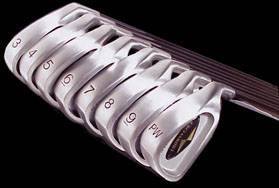
One of the most common terms you will hear in the world of golf is “iron.” Irons are a type of golf club that are primarily used for approach shots, where the player aims to hit the ball to the green. Here is everything you need to know about irons:
- What are irons?
- Types of irons:
- Cavity-back irons: These irons have a hollowed-out area at the back of the clubhead. The weight is distributed around the perimeter, making them more forgiving and easier to hit for beginners and high-handicap players.
- Muscle-back irons: Also known as blade irons, muscle-back irons have a solid back and are favored by more skilled players. They offer better control and workability, but they require a higher level of skill to hit consistently.
- Usage and characteristics:
- How to choose the right iron:
- Clubhead design: If you are a beginner or have a higher handicap, cavity-back irons can provide more forgiveness and help improve your game. Skilled players may prefer the workability and control offered by muscle-back irons.
- Shaft material and flex: The material and flex of the shaft can affect the feel and performance of the iron. Steel shafts are more common and offer better control, while graphite shafts are lighter and provide more distance.
- Clubfitting: Getting a clubfitting session can help determine the ideal iron specifications for your swing. Factors like shaft length, lie angle, and grip size can impact your ability to hit consistent, accurate shots.
- Proper iron shot technique:
- Stance and posture: Stand with your feet shoulder-width apart and align your body parallel to the target line. Bend your knees slightly and maintain good posture throughout the swing.
- Ball position: For most iron shots, the ball should be positioned slightly forward in your stance, just ahead of the center.
- Swing tempo and weight transfer: Maintain a smooth and balanced swing tempo, shifting your weight from your back foot to your front foot as you swing through the ball.
- Impact and follow-through: Make sure to strike down on the ball, taking a divot after contact. Follow through smoothly, with your arms extending towards the target.
Irons are golf clubs with a solid, flat-faced head, typically made of metal. Unlike woods, which have a larger, hollow-headed design, irons have a more compact construction. They are numbered from 1 to 9, with the numbers indicating the different degrees of loft.
There are two main categories of irons: cavity-back irons and muscle-back irons.
Irons are primarily used for shorter shots, typically within 200 yards from the green. They provide more accuracy and control compared to woods, making them ideal for precision shots.
Each iron has a different loft angle, which affects the trajectory and distance of the ball. Lower-numbered irons, such as 3 or 4 irons, have lower lofts and are used for longer shots with a lower ball flight. Higher-numbered irons, like 8 or 9 irons, have higher lofts, resulting in higher shots that land softer on the green.
Choosing the right iron for your game depends on your skill level, swing speed, and personal preference. Here are a few factors to consider:
To hit solid iron shots, it is important to focus on proper technique:
Now that you are familiar with the term “iron” and its significance in golf, you can confidently choose the right iron for your game and improve your performance on the greens!





